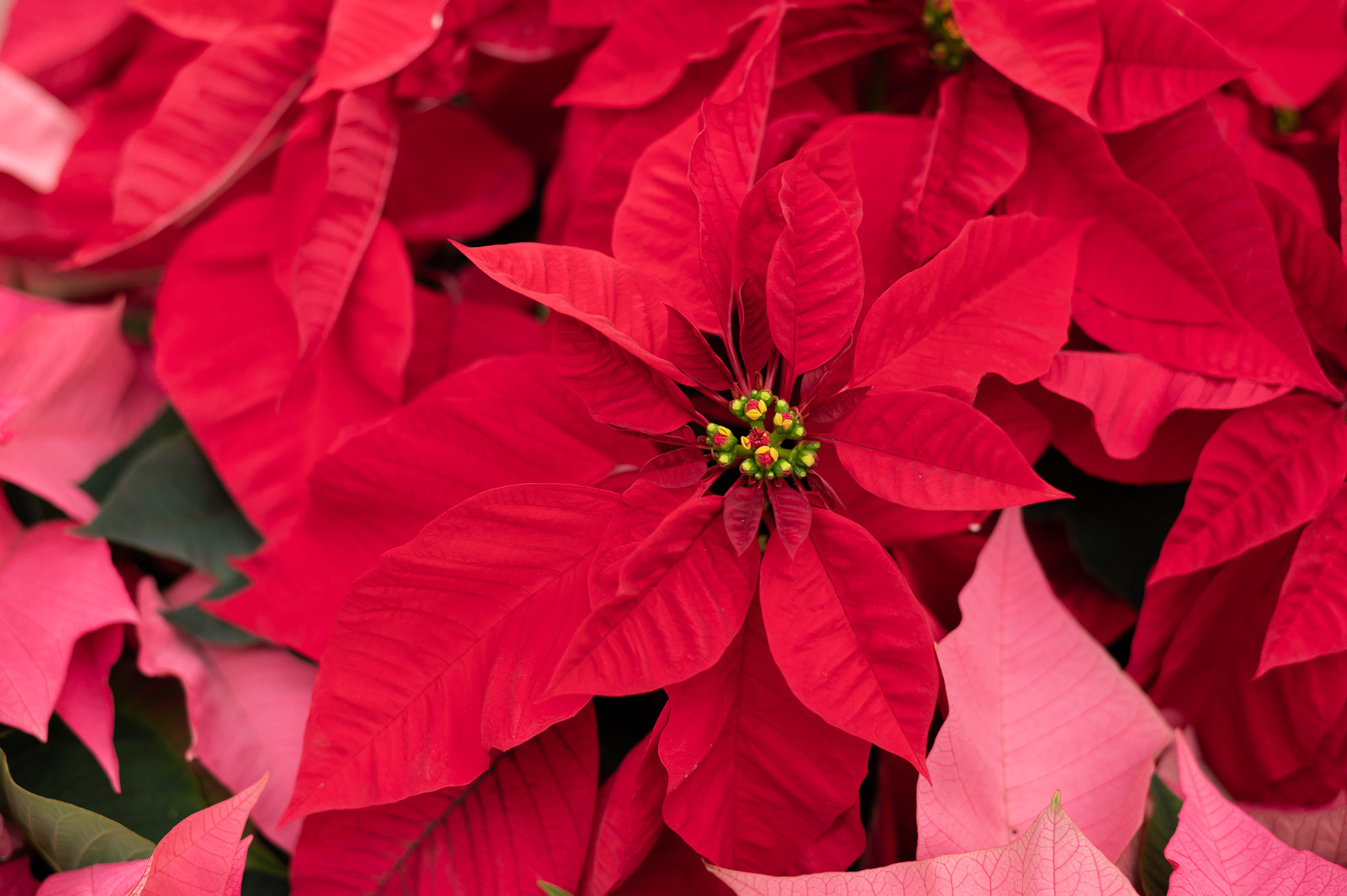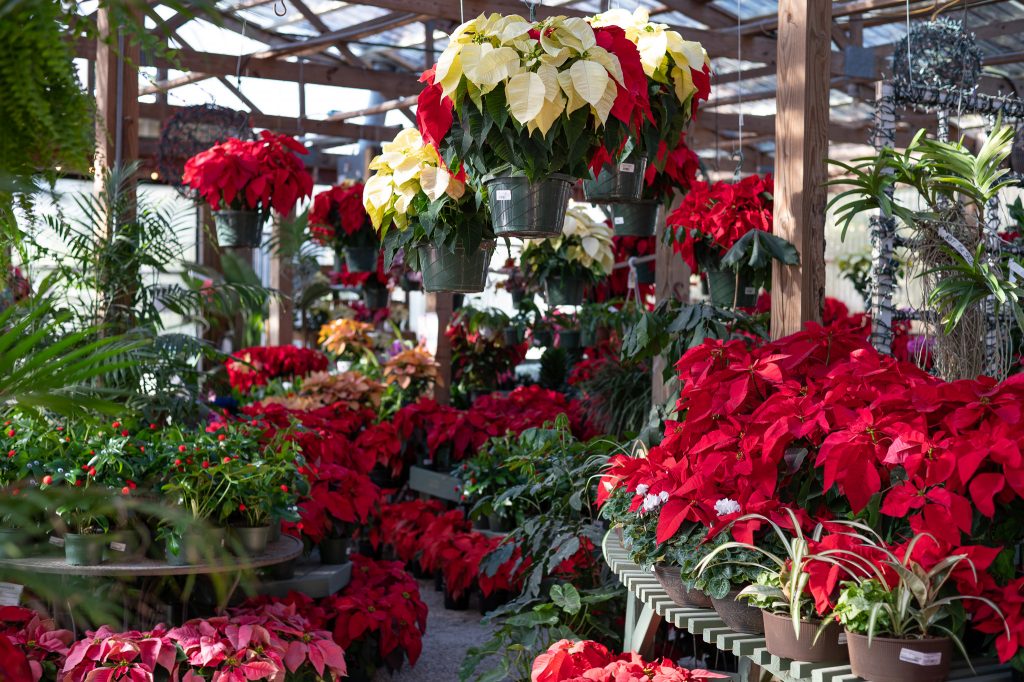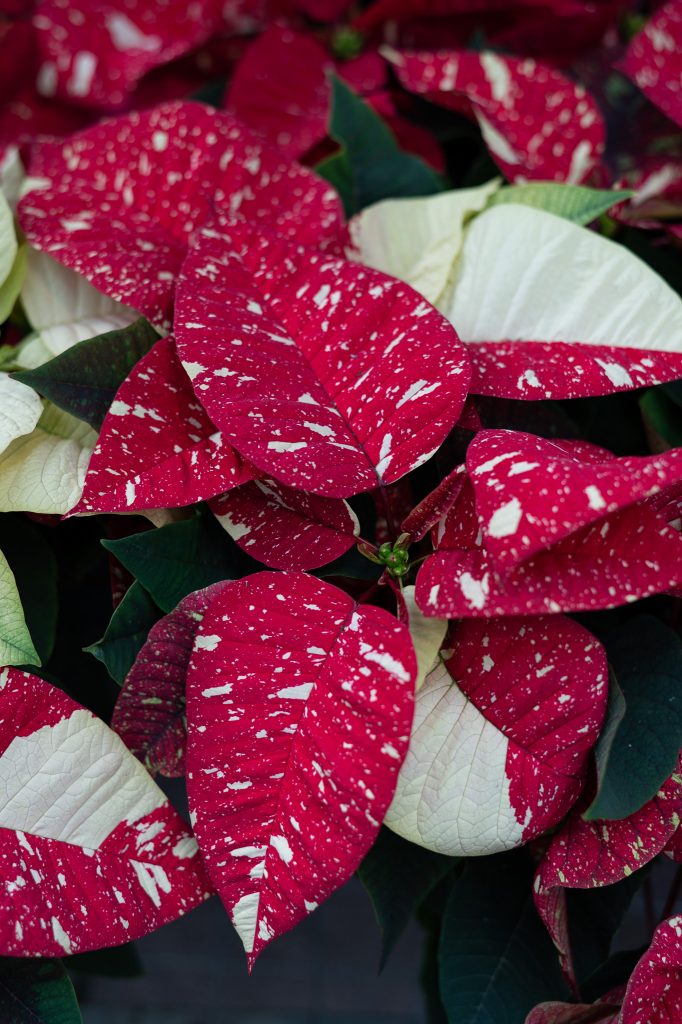
Holiday Plant Spotlight: Caring for Poinsettias
Poinsettias: a sign of the season!
Emblematic of the holiday season, the poinsettia has been known by many names over the past few centuries. It’s often called the flor de Nochebuena (“Christmas flower”) in Mexico, and the French recognize it as the étoile de Noël (“star of Christmas”). Most people in the English-speaking world know it as the poinsettia, but other names have come in and out of fashion, such as the “Mexican flame flower” or “painted leaf plant.”
Poinsettias are actually small shrubs that are native to Central America and southern Mexico. A Mexican legend from the sixteenth century tells the story of a poor, young girl named Lola who picked a bouquet of weeds to offer as a gift at the Nativity. Since her gift was one of pure love, once she entered the church, the bouquet was transformed into a display of beautiful red flowers. These iconic red “flowers” on the poinsettia are actually called bracts, which is a type of special leaf, and they can be a wide variety of colors, depending on the cultivar. The true flowers of the poinsettia are quite small, usually yellow in color, and are found in the very center of each group of bracts.
Poinsettias are generally bought or gifted during the holidays as houseplants, and they have a reputation of being somewhat finicky. With the right care, a poinsettia can be maintained long after the Christmas tree comes down. With some perseverance, they can rebloom in time for next year.
These plants come in a plethora of color options, such as red, pink and orange, and even vibrant green. There are double blooming varieties and varieties with long, strapy petals.
Light & Temperature Needs
Keeping in mind that poinsettias grow naturally in Central America and Mexico, we need to simulate that environment in order for the plant to thrive in our homes. Although light from the sun is less intense in the winter months than it is during the summer, direct sunlight could still burn the delicate leaves of the plant. Bright, indirect light is best, so position the plant near an east, west, or south-facing window. Poinsettias also prefer higher humidity, and they need an average room temperature of 65° to 75° during the day. The plant can tolerate (and actually prefers) a slightly lower temperature at night, but never expose it to temperatures below 50°. Fluctuations in temperature will cause leaf drop, so make sure that the plant is protected from drafts, doors, radiators, or heating vents.
Watering
Poinsettias don’t need a lot of water, but they can’t be left to dry out between waterings like some plants can. A good test is to put your index finger an inch or two into the soil to check for moisture. The soil should remain slightly moist at all times. If it’s completely dry, give the plant a drink, but don’t saturate it. Soggy or muddy soil will quickly lead to root rot and rapid decline of the plant. Both overwatering and underwatering will cause the plant to wilt or yellow, so check the soil every day for the first few days until you get an idea of how often it needs water. When in doubt, it’s always better to stay on the drier side, rather than too wet. Poinsettias are similar to African violets in that they do not like their foliage to get wet. Water droplets on the leaves and bracts will cause spotting, so it’s best to avoid wetting the plant above the soil line. If you buy a poinsettia that’s wrapped in foil, make sure there are holes in the bottom of the pot and the foil to allow water to drain.
Extending the Life of Your Poinsettias
If you find that you’ve become attached to your poinsettia, or that you’re up for a challenge, it is possible to maintain the plant so that it can bloom again next year. Poinsettias naturally bloom in the spring, so in order for them to bloom closer to the holidays, we need to trick them into thinking that winter is earlier than usual. This means that the plant needs a short-day treatment where it’s exposed to less than 12 hours of daylight per day, just as it would be during the regular winter months. When winter actually arrives, the plant reacts as if it were spring, which is why it blooms at the “wrong time.”
Short-day Treatment:
The following process should only be attempted on a healthy plant. When selecting a poinsettia that you intend to maintain long-term, making sure that it’s in top shape from the beginning will increase its chances of survival beyond the holidays. Look for plants that aren’t wilting or showing signs of browning on the bottom leaves. If possible, pull the plant from the pot and examine the roots. A preponderance of white, firm roots is a sign of a healthy plant, and there’s a better chance that it will survive the stress of what’s to come. If more than half of the roots are brown or beginning to turn brown, the plant probably won’t be up to the challenge of a second bloom. Of course, a healthy plant must remain healthy throughout the holidays, so it’s important that it receives proper care if you plan to extend its life through the rest of the year. Maintain the plant normally through February, then follow the steps below to encourage a rebloom.
1. Cut back on watering the plant around March or April. Only water enough to keep the stem alive. Most of the leaves will drop during this time.
2. At the beginning of the summer, about May, cut the plant down to 4-6 inches above the soil line. It will look very sad at this point, but at least it won’t look out-of-season anymore!
3. Continue to water the plant and provide bright, indirect light. You will have to water much less during this period, since the plant is so small.
4. Pinch off any new growth once per month throughout the summer. A complete fertilizer may be used throughout this period.
5. In mid-to-late September, the plant will need to begin a cycle of long nights and short days. This means that it needs to be in total darkness for 14-16 hours per day. It can be covered by a light-proof box or put into a closet during this time, but it still needs to come back out into the light for the other 8 hours of the day. A consistent regimen of day versus night exposure is crucial at this stage.
Eventually, the plant should come back out and hopefully bloom, returning to its former glory by mid-November. This process is very tedious, and many people don’t have the time or patience to keep up with it every day. There is no shame in composting your poinsettia after the holidays have passed and adopting a new one next year!
Come Visit the Greenhouse During the Holidays!

This article was written by Jordan Potter, Tallahassee Nurseries Greenhouse Team Member


